Toyota Matrix (2014 year). Instruction — part 3
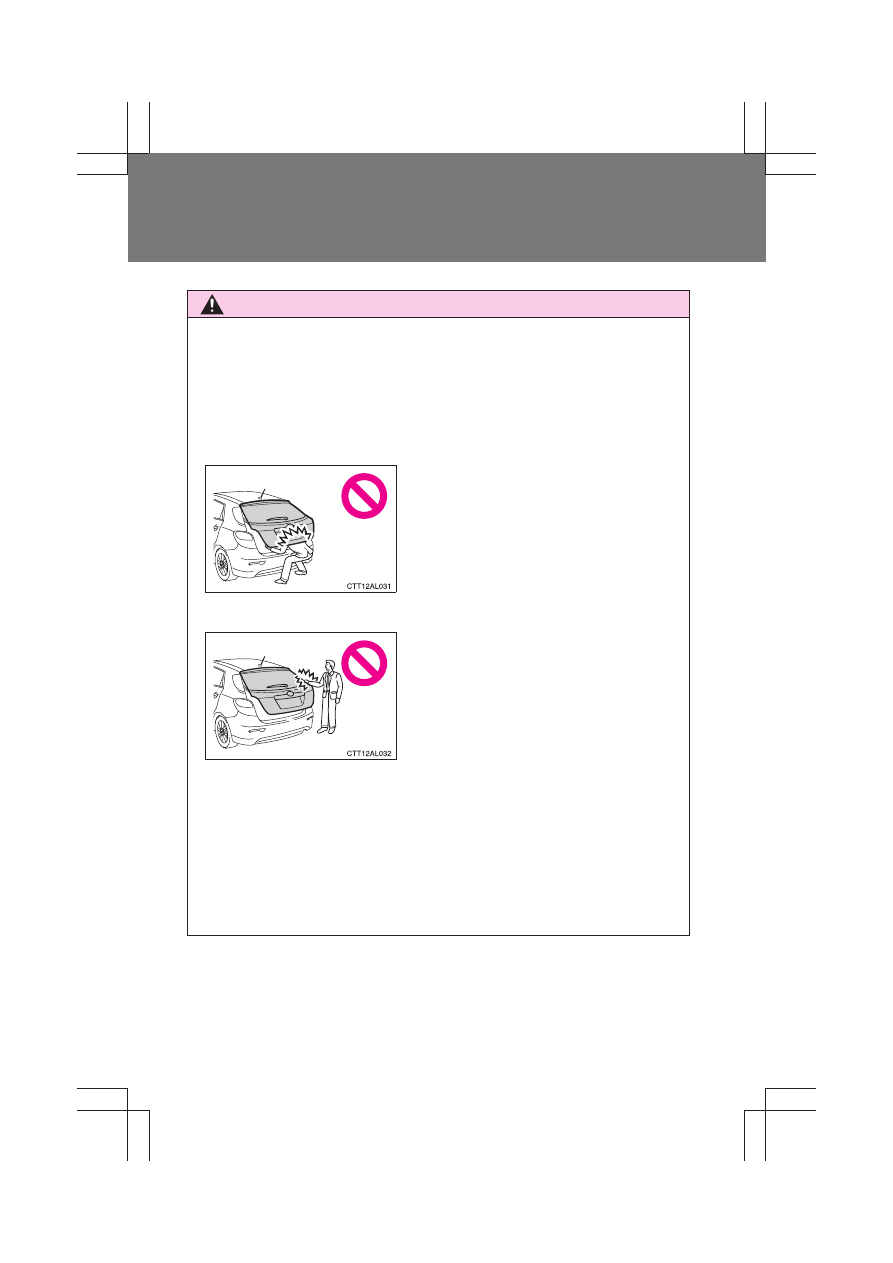
38
1-2. Opening, closing and locking the doors
MATRIX_U
CAUTION
●
When opening or closing the back door, thoroughly check to make sure
the surrounding area is safe.
●
If anyone is in the vicinity, make sure they are safe and let them know that
the back door is about to open or close.
●
Use caution when opening or closing the back door in windy weather as it
may move abruptly in strong wind.
●
Do not pull on the back door damper stay to close the back door, and do
not hang on the back door damper stay.
Doing so may cause hands to be caught or the back door damper stay to
break, causing an accident.
●
Do not attach any accessories other than genuine Toyota parts to the back
door. Such additional weight on the back door may cause the back door to
suddenly shut again after it is opened.
●
The back door may suddenly shut if it is
not opened fully. It is more difficult to
open or close the back door on an
incline than on a level surface, so
beware of the back door unexpectedly
opening or closing by itself. Make sure
that the back door is fully open and
secure before using the luggage com-
partment.
●
When closing the back door, take extra
care to prevent your fingers etc. from
being caught.
●
When closing the back door, make sure
to press it lightly on its outer surface. If
the back door handle is used to fully
close the back door, it may result in
hands or arms being caught.
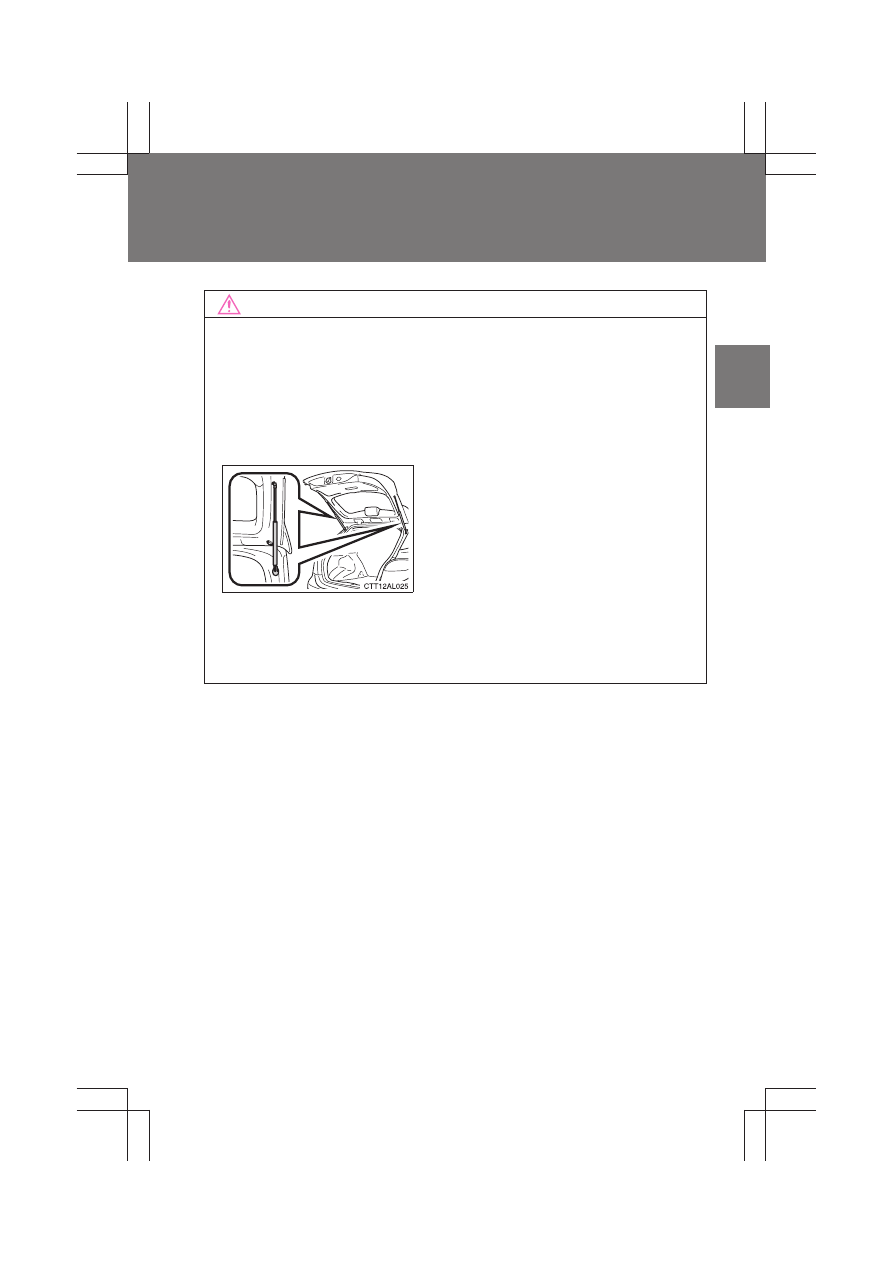
39
1-2. Opening, closing and locking the doors
1
Be
fo
re
d
riv
in
g
MATRIX_U
NOTICE
■
Back door damper stays
The back door is equipped with damper stays that hold the back door in
place.
Observe the following precautions.
Failure to do so may cause damage to the back door damper stay, resulting
in malfunction.
●
Do not attach any foreign objects, such
as stickers, plastic sheets, or adhesives
to the damper stay rod.
●
Do not touch the damper stay rod with
gloves or other fabric items.
●
Do not attach any accessories other
than genuine Toyota parts to the back
door.
●
Do not place your hand on the damper
stay or apply lateral forces to it.
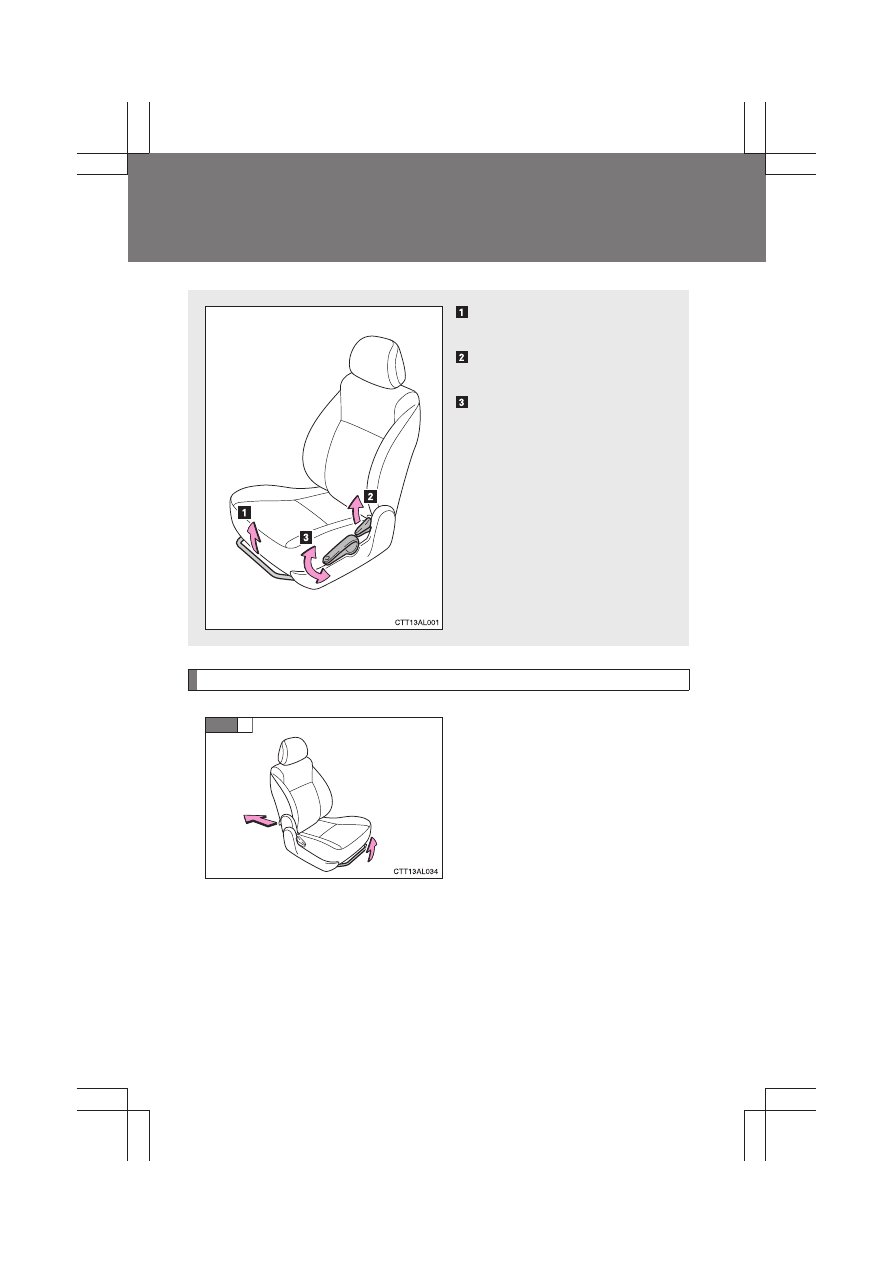
40
MATRIX_U
1-3. Adjustable components (seats, mirrors, steering wheel)
Front seats
Folding down the front passenger's seat (vehicles with seatback table)
Move the seat rearward.
Seat position adjustment
lever
Seatback angle adjustment
lever
Vertical height adjustment
lever (driver’s side only)
STEP
1

41
1-3. Adjustable components (seats, mirrors, steering wheel)
1
Be
fo
re
d
riv
in
g
MATRIX_U
Lower the head restraint and fix
the seatback at the most upright
lock position.
Pull up either seatback lock
release knob beside the seat-
back and fold the seatback
down.
Active head restraints
When the occupant’s back
presses against the seatback
during a rear-end collision, the
head restraint moves slightly for-
ward to help reduce the risk of
whiplash on the seat occupant.
STEP
2
STEP
3
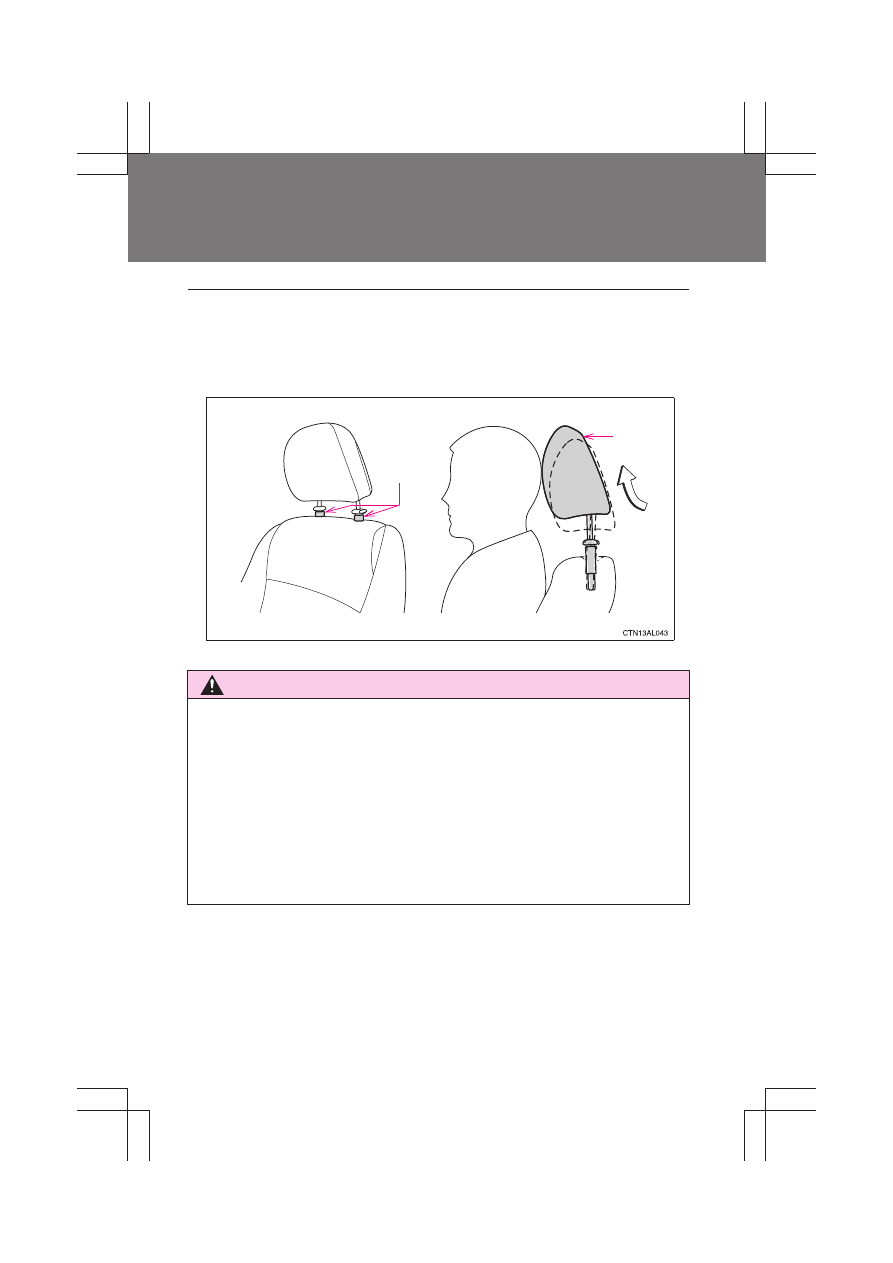
42
1-3. Adjustable components (seats, mirrors, steering wheel)
MATRIX_U
■
Active head restraints
Even small forces applied to the seatback may cause the head restraint to
move. Pushing up a locked head restraint forcibly may appear the head
restraint inner structure. These do not indicate problems.
CAUTION
■
Seat adjustment
●
Be careful that the seat does not hit passengers or luggage.
●
Do not recline the seat more than necessary when the vehicle is in motion
to reduce the risk of sliding under the lap belt.
If the seat is too reclined, the lap belt may slide past the hips and apply
restraint forces directly to the abdomen or your neck may contact the
shoulder belt, increasing the risk of death or serious injury in the event of
an accident.
●
After adjusting the seat, make sure that the seat is locked in position.
Inner
structure
During
rear-end
collision
43
1-3. Adjustable components (seats, mirrors, steering wheel)
1
Be
fo
re
d
riv
in
g
MATRIX_U
CAUTION
■
After returning the seatback to the upright position (vehicles with seat-
back table)
Make sure the seatback is securely locked by pressing forward and rear-
ward on the top of the seatback. Failure to do so will prevent seat belt from
operating properly.
■
Caution while driving (vehicles with seatback table)
Do not sit on or place anything on the folded seatback.
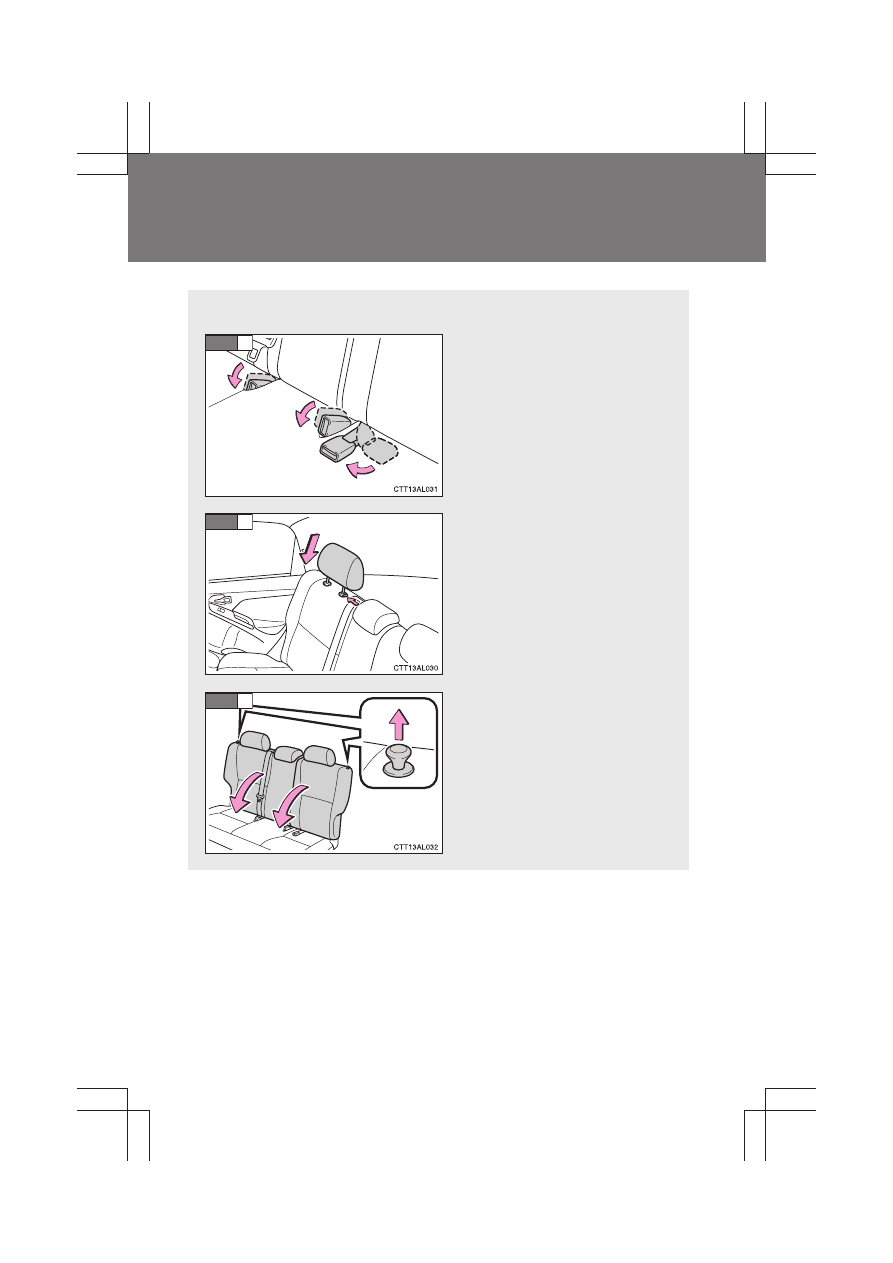
44
1-3. Adjustable components (seats, mirrors, steering wheel)
MATRIX_U
Rear seats
The seatbacks of the rear seats can be folded down.
Stow the rear outside seat belt
buckles and move the rear
center seat belt buckle as
shown.
Lower the head restraints to
the lowest position.
Fold the seatback down while
pulling the seatback lock
release knob.
STEP
1
STEP
2
STEP
3
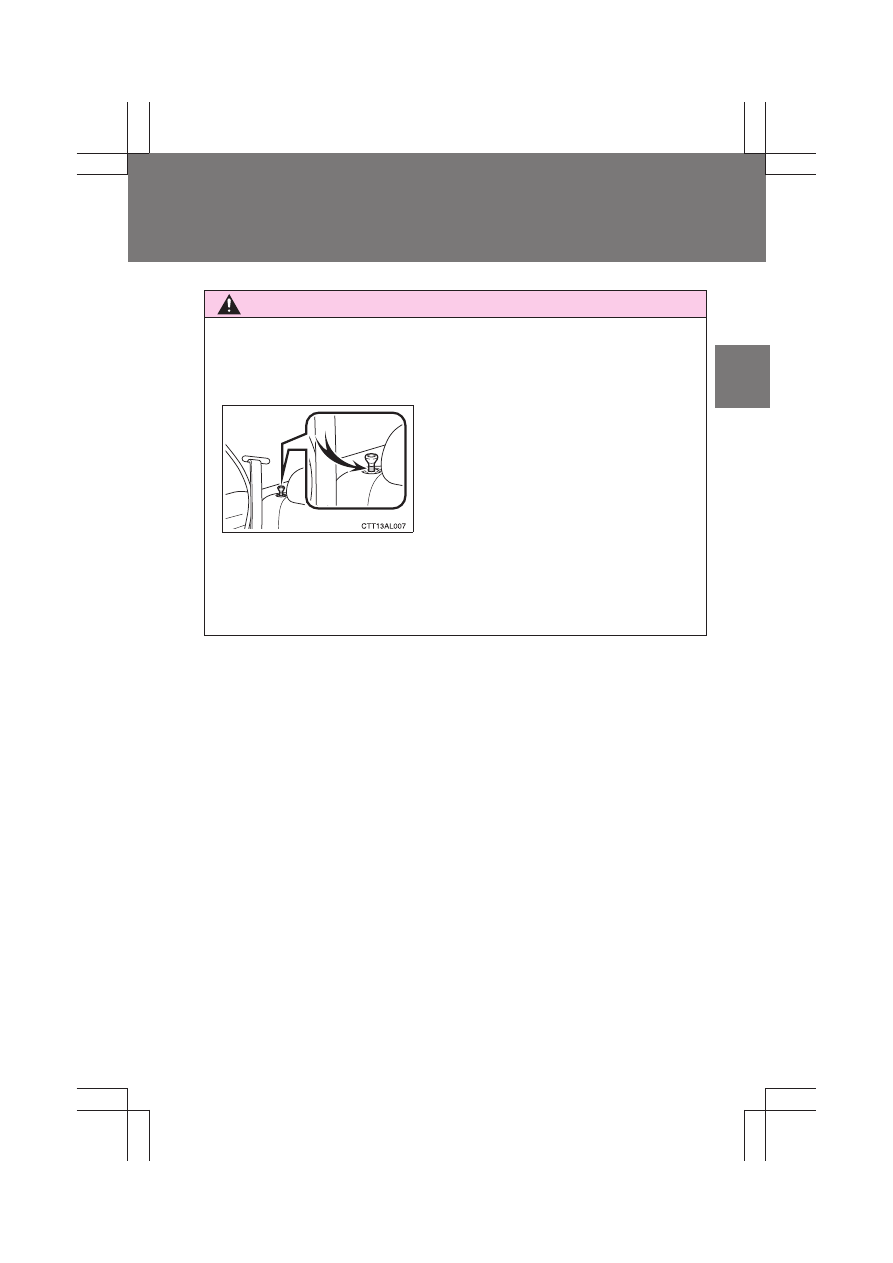
45
1-3. Adjustable components (seats, mirrors, steering wheel)
1
Be
fo
re
d
riv
in
g
MATRIX_U
CAUTION
■
After returning the seatback to the upright position
Observe the following precautions. Failure to do so may result in death or
serious injury.
●
Check that the seat belts are not twisted or caught in the seatback.
■
Caution while driving
Do not sit on the folded seatback.
●
Make sure that the seatback is
securely locked in position by lightly
rocking it back and forth.
If the seatback is not securely locked,
the red marking will be visible on the
seatback lock release knob. Make
sure that the red marking is not visi-
ble.
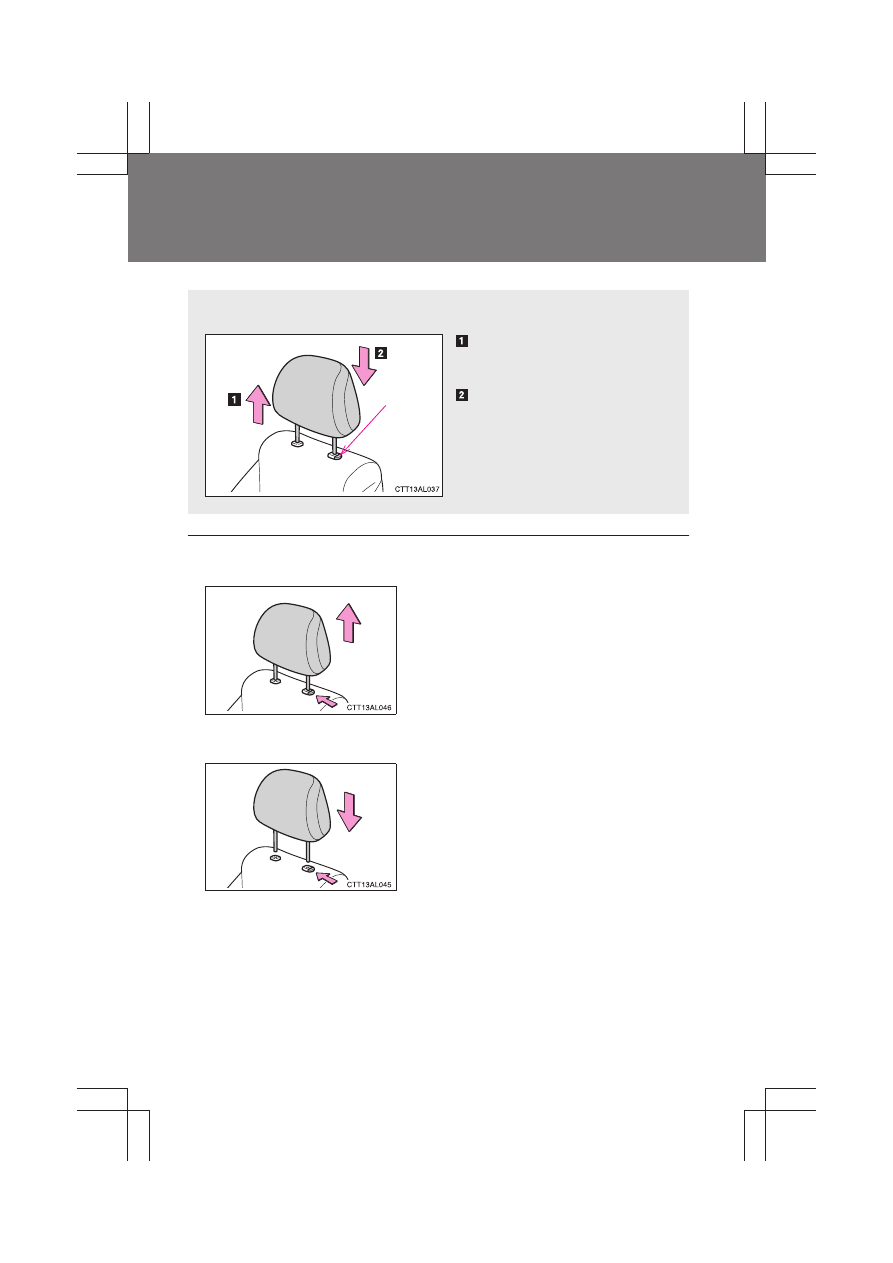
46
1-3. Adjustable components (seats, mirrors, steering wheel)
MATRIX_U
Head restraints
■
Removing the head restraints
■
Installing the head restraints
Head restraints are provided for all seats.
Up
Pull the head restraints up.
Down
Push the head restraint down
while pushing the lock release
button.
Lock
release
button
Pull the head restraint up while pushing
the lock release button.
Align the head restraint with the installa-
tion holes and push it down while press-
ing the lock release button.
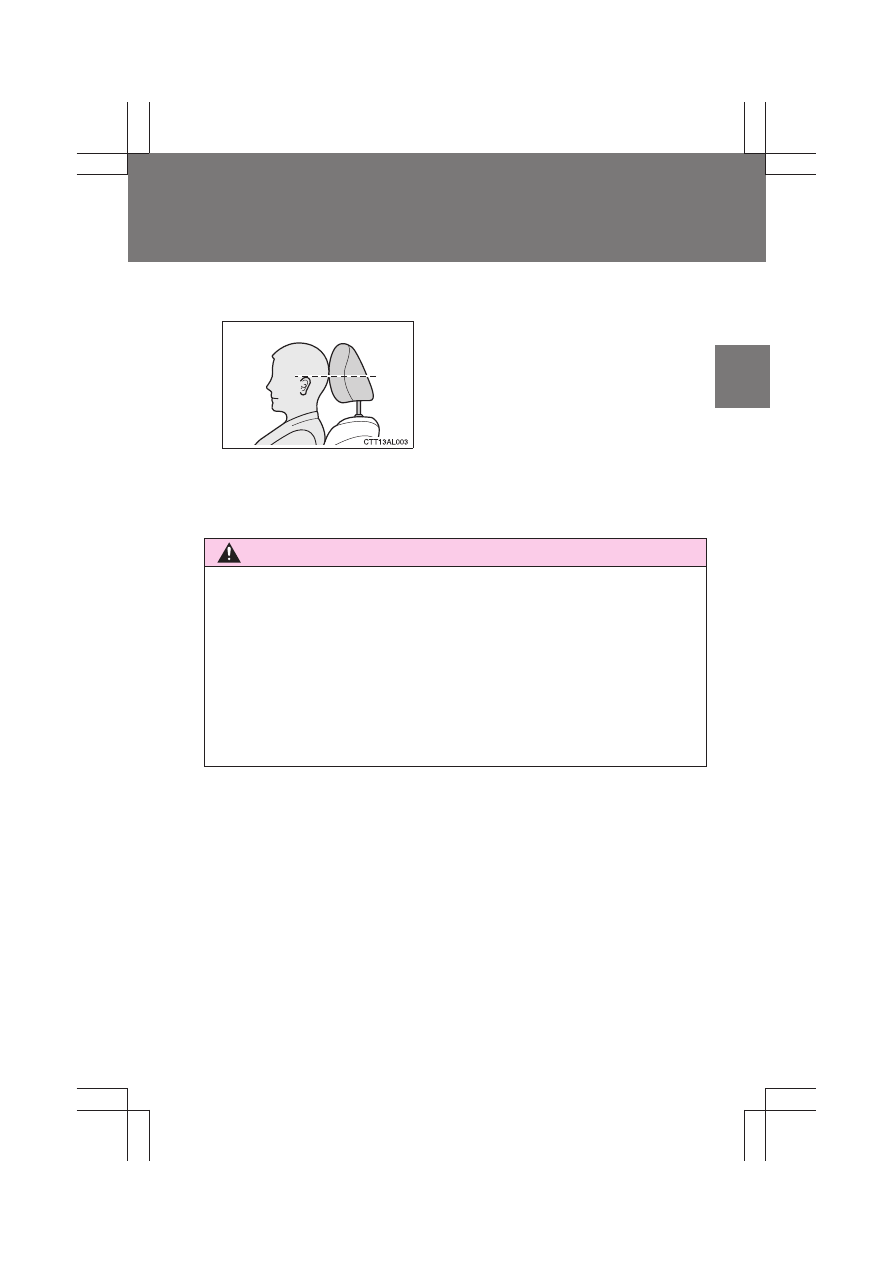
47
1-3. Adjustable components (seats, mirrors, steering wheel)
1
Be
fo
re
d
riv
in
g
MATRIX_U
■
Adjusting the height of the head restraints
■
Adjusting the rear center seat head restraint
Always raise the head restraint one level from the stowed position when
using.
CAUTION
■
Head restraint precautions
Observe the following precautions regarding the head restraints. Failure to
do so may result in death or serious injury.
●
Use the head restraints designed for each respective seat.
●
Adjust the head restraints to the correct position at all times.
●
After adjusting the head restraints, push down on them and make sure
they are locked in position.
●
Do not drive with the head restraints removed.
Make sure that the head restraints are
adjusted so that the center of the head
restraint is closest to the top of your ears.
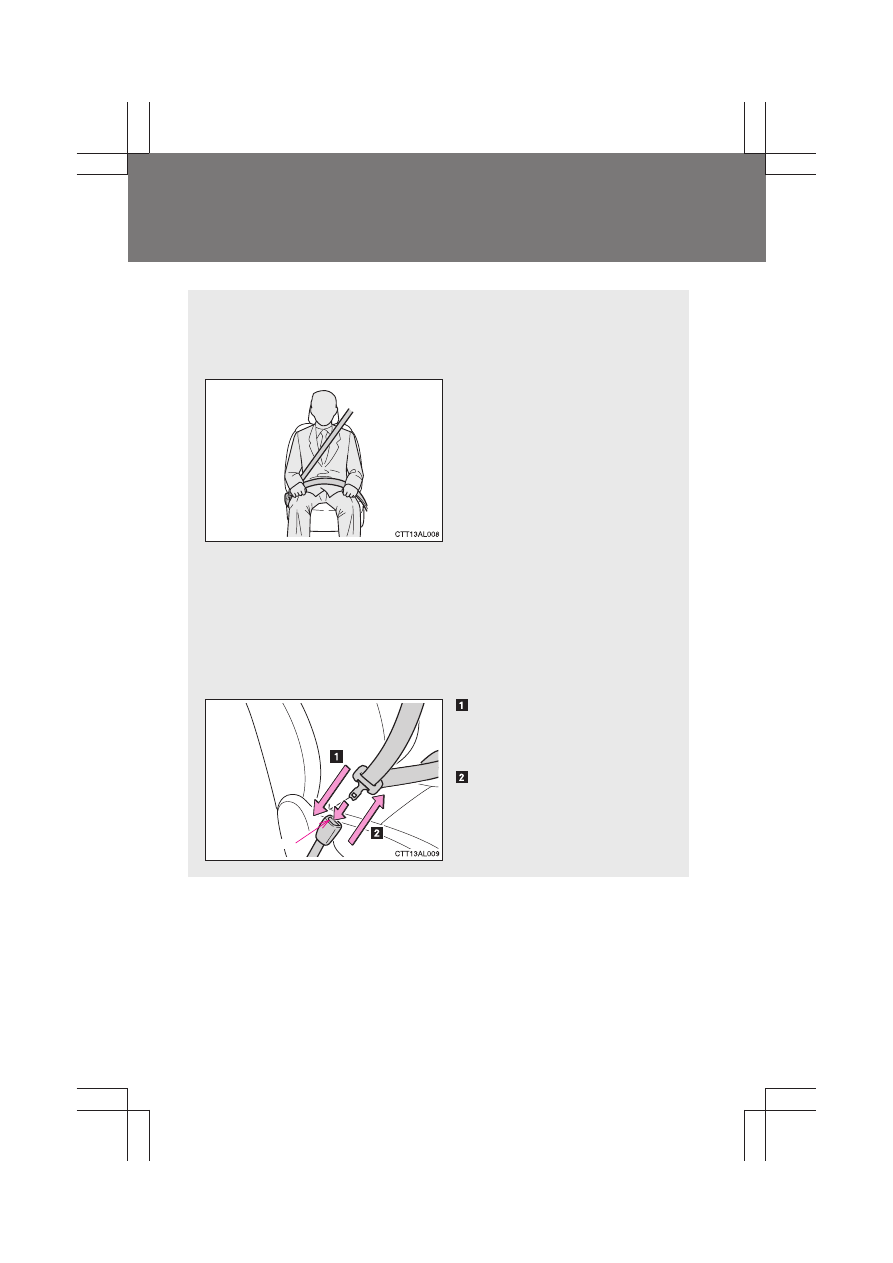
48
1-3. Adjustable components (seats, mirrors, steering wheel)
MATRIX_U
Seat belts
Make sure that all occupants are wearing their seat belts before driv-
ing the vehicle.
■
Correct use of the seat belts
● Extend the shoulder belt so
that it comes fully over the
shoulder, but does not
come into contact with the
neck or slide off the shoul-
der.
● Position the lap belt as low
as possible over the hips.
● Adjust the position of the
seatback. Sit up straight
and well back in the seat.
● Do not twist the seat belt.
■
Fastening and releasing the seat belt
Fastening the belt
Push the tab into the buckle
until a clicking sound is heard.
Releasing the belt
Press the release button.
Release button

49
1-3. Adjustable components (seats, mirrors, steering wheel)
1
Be
fo
re
d
riv
in
g
MATRIX_U
Seat belt pretensioners (front seats)
The pretensioner helps the seat
belt to quickly restrain the occu-
pant by retracting the seat belt
when the vehicle is subjected to
certain types of severe frontal
collision.
The pretensioner may not acti-
vate in the event of a minor frontal
impact, a side impact or a rear
impact.
■
Adjusting the height of the belt (front seats)
Push the seat belt shoulder
anchor down while pressing
the release button.
Push the seat belt shoulder
anchor up.
Move the height adjuster up
and down as needed.
■
Emergency locking retractor (ELR)
The retractor will lock the belt during a sudden stop or on impact. It may also
lock if you lean forward too quickly. A slow, easy motion will allow the belt to
extend so that you can move around fully.
■
Automatic locking retractor (ALR)
When a passenger's shoulder belt is completely extended and then
retracted even slightly, the belt is locked in that position and cannot be
extended. This feature is used to hold the child restraint system (CRS) firmly.
To free the belt again, fully retract the belt and then pull the belt out once
more. (
→P. 94)
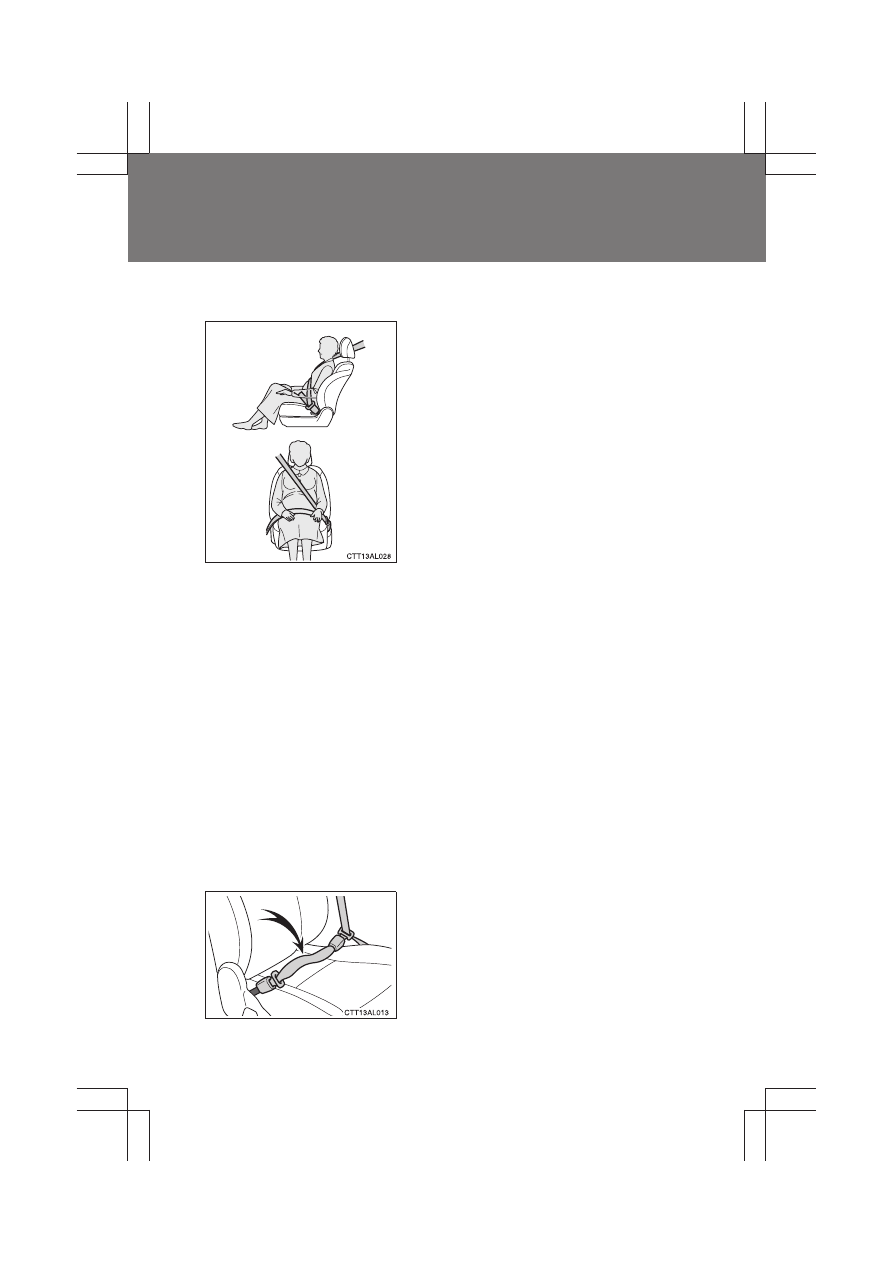
50
1-3. Adjustable components (seats, mirrors, steering wheel)
MATRIX_U
■
Pregnant women
■
People suffering illness
Obtain medical advice and wear the seat belt in the proper way.
■
Child seat belt usage
The seat belts of your vehicle were principally designed for persons of adult
size.
●
Use a child restraint system appropriate for the child, until the child
becomes large enough to properly wear the vehicle's seat belt. (
→P. 90)
●
When the child becomes large enough to properly wear the vehicle's seat
belt, follow the instructions on P. 48 regarding seat belt usage.
■
Replacing the belt after the pretensioner has been activated
If the vehicle is involved in multiple collisions, the pretensioner will activate
for the first collision, but will not activate for the second or subsequent colli-
sions.
■
Seat belt extender
Obtain medical advice and wear the seat
belt in the proper way. (
→P. 48)
Women who are pregnant should position
the lap belt as low as possible over the
hips in the same manner as other occu-
pants. Extend the shoulder belt com-
pletely over the shoulder and position the
belt across the chest. Avoid belt contact
over the rounding of the abdominal area.
If the seat belt is not worn properly, not
only a pregnant woman, but also the fetus
could suffer death or serious injury as a
result of sudden braking or a collision.
If your seat belts cannot be fastened
securely because they are not long
enough, a personalized seat belt
extender is available from your Toyota
dealer free of charge.
51
1-3. Adjustable components (seats, mirrors, steering wheel)
1
Be
fo
re
d
riv
in
g
MATRIX_U
CAUTION
Observe the following precautions to reduce the risk of injury in the event of
sudden braking, sudden swerving or an accident.
Failing to do so may cause death or severe injury.
■
Wearing a seat belt
●
Ensure that all passengers wear a seat belt.
●
Always wear a seat belt properly.
●
Each seat belt should be used by one person only. Do not use a seat belt
for more than one person at once, including children.
●
Toyota recommends that children be seated in the rear seat and always
use a seat belt and/or an appropriate child restraint system.
●
Do not recline the seat any more than necessary to achieve a proper seat-
ing position. The seat belt is most effective when the occupants are sitting
up straight and well back in the seats.
●
Do not wear the shoulder belt under your arm.
●
Always wear your seat belt low and snug across your hips.
■
Child restraint lock function belt
Do not allow children to play with the child restraint lock function belt. If the
belt becomes twisted around a child’s neck, it will not be possible to pull the
belt out leading to choking or other serious injuries that could result in death.
If this occurs and the buckle cannot be unfastened, scissors should be used
to cut the belt.
52
1-3. Adjustable components (seats, mirrors, steering wheel)
MATRIX_U
CAUTION
■
Seat belt pretensioners
●
Do not place anything, such as a cushion, on the front passenger's seat.
Doing so will disperse the passenger's weight, which prevents the sensor
from detecting the passenger's weight properly. As a result, the seat belt
pretensioner for the front passenger's seat may not activate in the event of
a collision.
●
If the pretensioner has activated, the SRS warning light will come on. In
that case, the seat belt cannot be used again and must be replaced at
your Toyota dealer.
■
Adjustable shoulder anchor
Always make sure the shoulder belt is positioned across the center of your
shoulder. The belt should be kept away from your neck, but not falling off
your shoulder. Failure to do so could reduce the amount of protection in an
accident and cause death or serious injuries in the event of a sudden stop,
sudden swerve or accident. (
→P. 49)
■
Seat belt damage and wear
●
Do not damage the seat belts by allowing the belt, plate, or buckle to be
jammed in the door.
●
Inspect the seat belt system periodically. Check for cuts, fraying, and loose
parts. Do not use a damaged seat belt until it is replaced. Damaged seat
belts cannot protect an occupant from death or serious injury.
●
Ensure that the belt and tab are locked and the belt is not twisted.
If the seat belt does not function correctly, immediately contact your Toyota
dealer.
●
Replace the seat assembly, including the belts, if your vehicle has been
involved in a serious accident, even if there is no obvious damage.
●
Do not attempt to install, remove, modify, disassemble or dispose of the
seat belts. Have any necessary repairs carried out by your Toyota dealer.
Inappropriate handling of the pretensioner may prevent it from operating
properly resulting in death or serious injury.

53
1-3. Adjustable components (seats, mirrors, steering wheel)
1
Be
fo
re
d
riv
in
g
MATRIX_U
CAUTION
■
Using a seat belt extender
●
Do not wear the seat belt extender if you can fasten the seat belt without
the extender.
●
Do not use the seat belt extender when installing a child restraint system
because the belt will not securely hold the child restraint system, increas-
ing the risk of death or serious injury in the event of an accident.
●
The personalized extender may not be safe on another vehicle, when
used by another person, or at a different seating position other than the
one originally intended.
NOTICE
■
When using a seat belt extender
When releasing the seat belt, press on the buckle release button on the
extender, not on the seat belt.
This helps prevent damage to the vehicle interior and the extender itself.

Нет комментариевНе стесняйтесь поделиться с нами вашим ценным мнением.
Текст